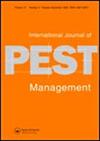植物性杀虫剂对红棕象鼻虫幼虫期的防治效果及昆虫病原线虫的存活
IF 1.1
4区 农林科学
Q3 ENTOMOLOGY
引用次数: 0
摘要
摘要植物油被认为是具有杀虫特性的生态友好化合物。本研究研究了罗勒(Ocimum basilicum)、樟脑(Cinnamomum camphora)、肉桂(Cinnamomum verum)、柠檬(Citrus limon)、丁香(Syzygium aromaticum)、生姜(Zingiber officinale)、黑胡椒(Piper nigrum)和橙子(Citrus sinensis var balady)油提取物对四种昆虫病线虫(steinerma属和Heterorhabditis属)存活的影响,以及对铁纹线虫卵孵化和幼虫的影响。樟脑油、柠檬油、黑胡椒油和橙油的孵卵率分别为0%、0%、16%和0%,分别为50 μL/mL。在相同浓度和48 h的处理条件下,其他油类的幼虫死亡率均达95%以上。角质层出现多种形态组织病理学改变;外角质层皱襞肿胀或收缩及角质层下肌肉变性,以及中肠;与对照组的幼虫相比,铁铁棘球绦虫幼虫的上皮内层有明显的变性和/或坏死的脂肪球。樟脑油对油菜斯坦纳马(S2)侵染幼虫(IJs)的死亡率(50%)显著低于马氏异虫(D1)、油菜斯坦纳马(Sr)和油菜斯坦纳马(All)。从所获得的精油致死效应观察结果来看,开发具有杀虫特性的精油与线虫混合配制的整体生物防治产品(而不是线虫存活)的目标是可能的;一种可持续和环保的有害生物管理产品。关键词:红棕weevilSteinernema spp.Heterorhabditis spp.essential oilintegrated病虫害治理AcknowledgmentThe作者要感谢现场调查人员,帮助在调查地点收集标本。作者感谢Sadat City大学遗传工程与生物技术研究所和Dokki国家研究中心对本文的支持,并为其提供了开展研究计划所需的基础设施和设施。作者报告无利益竞争需要申报。数据可用性声明数据可根据要求从通讯作者处获得。本研究是埃及国家研究中心以下研究项目的一部分:nt.allam@nrc.sci.eg用于鉴定、系统发育分析和诊断卵巢发情、痒头和犀牛发情的分子方法。寄生于绵羊、山羊、骆驼和马的幼虫[No. 1]。[10120507]和基于酚类和黄酮类化合物的重组txp40 -环肽候选物的纳米颗粒构建及其在鼻蝇病诱导寄生虫生物防治中的应用[j]。11040301)。本文章由计算机程序翻译,如有差异,请以英文原文为准。
Effectiveness of botanical insecticides on larval stage of red palm weevil Rhynchophorous ferrugineus and survival of entomopathogenic nematodes
AbstractBotanical oils are considered ecofriendly compounds with insecticidal characteristics. In this study, the effects of basil (Ocimum basilicum), camphor (Cinnamomum camphora), cinnamon (Cinnamomum verum), lemon (Citrus limon), clove (Syzygium aromaticum), ginger (Zingiber officinale), black pepper (Piper nigrum), and orange (Citrus sinensis var balady) oil extracts on the survival of four entomopathogenic nematode strains belonging to the Steinernema and Heterorhabditis genera, as well as their impacts on Rhynchophorus ferrugineus egg hatching and larvae, were assessed. The results for the camphor, lemon, black pepper, and orange oils were promising as 50 μL/mL of each resulted in 0%, 0%, 16%, and 0% hatchability for the R. ferrugineus eggs, respectively. Furthermore, the mortality of R. ferrugineus larvae was up to 95% with the similar concentrations and an exposure time of 48 h, for the other investigated oils. Various morphohistopathological alterations were found in the cuticle; outer cuticle folds swelling or shrinkage and subcuticular muscle degeneration, as well as midgut; fat globules in the epithelial lining with marked degeneration and/or necrosis, of the R. ferrugineus larvae when compared with those of controls replicates. Mortality percentage of infective juveniles (IJs) of Steinernema carpocapsae (S2) was significantly lower than Heterorhabditis marelatus (D1), Steinernema riobravae (Sr) and Steinernema carpocapsae (All) when using camphor oil compared to the other oils (50%). From the obtained observations on oils lethal effects, the target of developing integral biocontrol product formulated from combinations of essential oils and nematode with insecticidal properties against R. ferrugineus (not nematode survival) is possible; a sustainable and ecofriendly product for pest management.Keywords: Red palm weevilSteinernema spp.Heterorhabditis spp.essential oilintegrated pest management AcknowledgmentThe authors would like to thank the field investigators, who helped in collecting specimens in investigated locality. The authors gratefully thank the Genetic Engineering and Biotechnology Research Institute-University of Sadat City, and National Research Centre- Dokki for their support of this paper with the infrastructure and facilities to carry out the research plan.Disclosure statementThe authors report there are no competing interests to declare.Data availability statementData are available from the corresponding author upon request.Additional informationFundingThis study was a part of the following research projects in the National Research Centre, Egypt: nt.allam@nrc.sci.eg Molecular Approaches for Characterization, Phylogenetic Analysis, and Diagnosis of Oestrus ovis, Cephalopina titillator, and Rhinoestrus spp. Larvae Obligatory Parasitizing Sheep, Goats, Camels, and Equines [No. 10120507] and Nanoparticle Construction of recombinant Txp40-Cyclopeptides candidates attached to Phenols and Flavonoids fractions as novel preparation applied in biological control of some nasal myiasis inducing parasites [No. 11040301].
求助全文
通过发布文献求助,成功后即可免费获取论文全文。
去求助
来源期刊
CiteScore
4.70
自引率
6.70%
发文量
74
审稿时长
>12 weeks
期刊介绍:
International Journal of Pest Management publishes original research papers and reviews concerned with pest management in the broad sense, covering the control of pests (invertebrates, vertebrates and weeds) and diseases of plants, fungi and their products – including biological control, varietal and cultural control, chemical controland interference methods.
The management of invasive species is of special interest. We also encourage submissions dealing with interactions of multiple pests such as arthropods and plant pathogens, pathogens and weeds or weeds and arthropods as well as those dealing with the indirect and direct effects of climate change on sustainable agricultural practices.

 求助内容:
求助内容: 应助结果提醒方式:
应助结果提醒方式:


